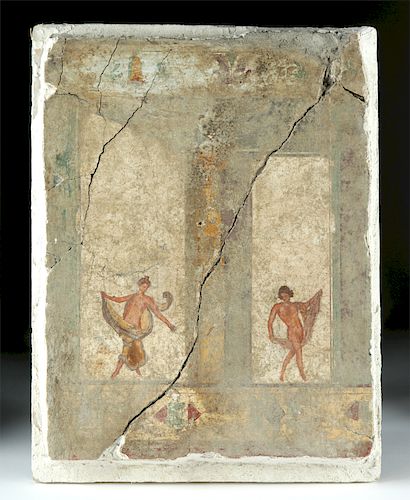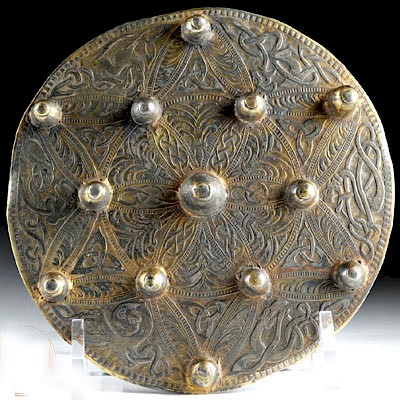Rare Roman Fresco, Fourth Style Painting
Lot 31b
About Seller
Artemis Fine Arts
686 S Taylor Ave, Ste 106
Louisville, CO 80027
United States
Selling antiquities, ancient and ethnographic art online since 1993, Artemis Gallery specializes in Classical Antiquities (Egyptian, Greek, Roman, Near Eastern), Asian, Pre-Columbian, African / Tribal / Oceanographic art. Our extensive inventory includes pottery, stone, metal, wood, glass and textil...Read more
Estimate:
$15,000 - $30,000
Absentee vs Live bid
Two ways to bid:
- Leave a max absentee bid and the platform will bid on your behalf up to your maximum bid during the live auction.
- Bid live during the auction and your bids will be submitted real-time to the auctioneer.
Bid Increments
| Price | Bid Increment |
|---|---|
| $0 | $25 |
| $300 | $50 |
| $1,000 | $100 |
| $2,000 | $250 |
| $5,000 | $500 |
| $10,000 | $1,000 |
| $20,000 | $2,500 |
| $50,000 | $5,000 |
| $100,000 | $10,000 |
| $200,000 | $20,000 |
About Auction
By Artemis Fine Arts
Jul 19, 2018
Set Reminder
2018-07-19 10:00:00
2018-07-19 10:00:00
America/New_York
Bidsquare
Bidsquare : Fine Antiquities/Ethnographic Art
https://www.bidsquare.com/auctions/artemis-gallery/fine-antiquities-ethnographic-art-3329
Featuring classical antiquities, ancient and ethnographic art from cultures encompassing the globe, plus fine art. Artemis Fine Arts info@artemisgallery.com
Featuring classical antiquities, ancient and ethnographic art from cultures encompassing the globe, plus fine art. Artemis Fine Arts info@artemisgallery.com
- Lot Description
Late Roman, ca. 1st century CE. An incredibly rare fresco painting depicting a pair of nude / partially nude women in dancelike poses within a colonnade, the petite women and their flowing scarves are delineated with fine lines and three-dimensional modeling, and the architecture is decorated with what appear to be phytomorphic and geometric motifs of sky blue, teal, golden yellow, red, and cream hues. In addition to the artist's ability to delineate depth of field and capture the movement of the lovely ladies below - clearly indicating the advances of Classical Art - the rarity of this piece is undeniable. Aside from vase painting, paintings from the Classical World are quite unusual, and this wall painting, possibly from Herculaneaum or Pompeii, is extremely rare. Size: 16.5" L x 12.75" W (41.9 cm x 32.4 cm)
This is an example of a Roman Fourth Style wall painting. Fourth Style paintings reflect a taste for illusionism and rose to popularity during the mid 1st century CE. According to art historian Fred Kleiner, "it was the preferred manner of mural decoration at Pompeii when the eruption of Vesuvius buried the town in volcanic ash in 79." In Fourth Style wall paintings, the walls were usually painted a creamy white, and the illusionistic compositions resulted in views beyond the wall that also presented irrational architectural vistas with figures that were oftentimes out of scale as displayed in this example. Interestingly, scholar Paul Zanker has stated that Fourth Style wall painting were designed to turn the rooms into picture galleries called pinacothecae. (See Zanker, P. 1998. Pompeii: Public and Private Life. Trans. D. L. Schneider. Cambridge, Massachusetts: Harvard University Press.)
Pompeii was destroyed by and buried under the ash of a volcanic eruption in the year 79 CE. This natural catastrophe resulted in the preservation of extraordinary archaeological remains of the Roman town. The remains of Pompeii have been an invaluable resource for studying the Roman world.
For a similar example, see panels of the upper border of the Fourth Style paintings in the Ixion Room (triclinium P) of the House of the Vetti (Casa dei Vettii), Pompeii, Italy, ca. 70-79 CE or room 78 of the Domus Aurea (Golden House) of Nero, Rome, Italy, 64-68 CE. (Fred Kleiner, Gardner's Art through the Ages, Volume 1, Figures 7-22 and 7-23, p. 195).
Provenance: private East Coast, USA collection; ex-William Froelich collection, New York, New York, 1970's
All items legal to buy/sell under U.S. Statute covering cultural patrimony Code 2600, CHAPTER 14, and are guaranteed to be as described or your money back.
A Certificate of Authenticity will accompany all winning bids.
We ship worldwide and handle all shipping in-house for your convenience.
#136222Repaired/restored from multiple pieces with some visible fissures. Cleaned by Joseph Ternbach in Forest Hills, New York in the mid to late 1950's. Relatively little touch up consolidation. Surface wear with some pitting, abrasions, and pigment loss commensurate with age. Set in a plaster matrix, with a wooden backing for added support.Condition
- Shipping Info
-
All shipping is handled in-house for your convenience. Your invoice from Artemis Gallery will include shipping calculation instructions. If in doubt, please inquire BEFORE bidding for estimated shipping costs for individual items.
-
- Buyer's Premium



 EUR
EUR CAD
CAD AUD
AUD GBP
GBP MXN
MXN HKD
HKD CNY
CNY MYR
MYR SEK
SEK SGD
SGD CHF
CHF THB
THB














